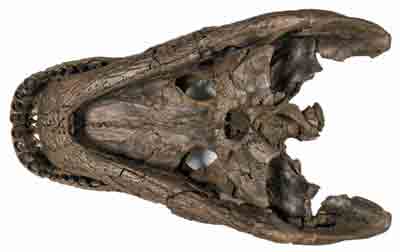The first fossil specimen was discovered in Montana at Hell Creek, a rock formation dating back to the end of the Cretaceous period.
Another specimen was also found in the Darbasa Formation of Kazakhstan, although it was not possible to classify its species.

Brachychampsa is distinguished by a fourth enlarged premolar in the upper jaw. He had short teeth and a large mouth with more power than the current alligators. These characteristics suggest that this reptile feeds on turtles, which are very common in the Hell Creek fossil fauna.
Although part of the Alligatoroidea superfamily, the phylogenetic analysis of Brachychampsa underwent several revisions. Originally the animal had been placed in the Alligatoridae family, and was then perfected in the subfamily of the Alligatorinae in 1964, only to be placed outside both Alligatorinae and Alligatoridae (but still within Alligatoroidea), in 1994.
The first ancestor of alligators dates back to 245 million years ago. Only about 80 million years ago, during the Cretaceous period, the first crocodiles appeared. This group includes both alligatoros, such as Brachychampsa, and its closest relatives such as crocodiles and caimans. Many of these ancient animals survived the great extinction of the K-T period. Modern alligators are still very similar and related to their ancient ancestors 80 million years ago.
The typical species of Brachychampsa, B. montana, was discovered in the Hell Creek Formation in Montana, described by Charles W. Gilmore in an article, in 1911. In that same document, Gilmore renamed Bottosaurus perrugosus as a new species of Brachychampsa, calling it B. perrugosus. The holotypical specimen of B. perrugosus disappeared as well as the paper that described it, but was subsequently rediscovered and shortly afterwards designated as nomen dubium due to the lack of diagnostic features that distinguished it from other alligatorids. Another species, from the Menefee Formation, of the San Juan Basin, B. sealeyi, was discovered in 1996, although it is thought that it may be a synonym of B. montana, specifically a young specimen of the latter species. However, other studies argue that some of the variations seen between the two species, such as the maxillary orientation of the tooth rows, can not be ontogenetic, making B. sealeyi a valid taxon.



